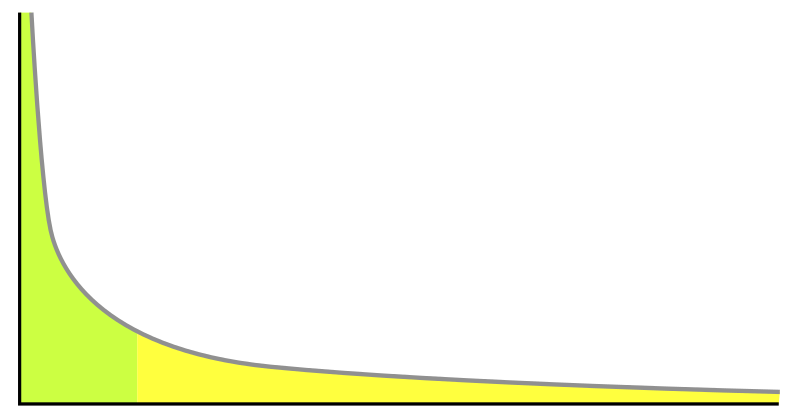Background
If you are not familiar with the concept of the Long Tail, head over to take a look at the Long Tail article on Wikipedia. It's a pretty good introduction to the main concepts around a very important concept. You can also look at getAbstract's - Abstract on Anderson's The Long Tail.
The core idea is that for retailers like Amazon, they sell very large volumes of titles that cannot even be carried in a bricks-and-mortar store.

Typical Long Tail
Carried further, when distribution, storage and production get lower, it becomes viable to sell relatively less popular products.

Thus, markets in Long Tail situations shift towards larger volumes of increasingly broader products with smaller volumes at the top.
This is happening in many situations: major publishers (CNN, Yahoo, Cnet) competing with niches publishers, competing with blogs; TV production facing a widely distributed audience across 500 cable channels and YouTube. There's quite a bit more on this in Long Tail SEO - 60+ Articles.
Since everyone still has the same amount of time to spend consuming all of these products or information, they are naturally going to spread their time over broader and broader range. This gives rise to the Attention Economy where the scarce resource is not distribution channels or information, the scarce resource is attention. Each person only has a certain amount of time. Where we choose to spend that time is important. And even if we are successful in getting someone’s attention, we often get Shorter Attention Spans and only getting partial attention - Stop Reading - Skim Dive Skim.
If you think about the Long Tail graph, it works just as well when we substitute Attention instead of Sales.
Impact
How does this impact the world of learning organizations and corporate learning functions (training organizations)? Consider the following:
- Corporate learning functions today act like a publisher / distributor.
- The average knowledge worker has access to an increasingly large set of information resources and corporate learning is an ever smaller part of this set.
- Cost is most often not a factor in a knowledge workers decision about the use of information. Time (attention) is much more important. Factored in is expectation of quality (how much time I need to spend filtering the content to determine if it’s of value). As a quick example, we choose our preferred search engine in large part because we feel it will be the best investment of time to find the best quality information.
- Information sources will continue to grow exponentially, so Corporate Learning as a traditional publisher will be able to focus on an ever smaller portion of the knowledge worker’s needs.
- John Hagel – in a post Paying Attention tells us:
If we do not receive attention, we risk becoming progressively marginalized. Receiving attention becomes far more important than it ever was and will require far more effort than in the past. Corporate learning is in the midst of an attention crisis.
- Corporate learning functions are seeking to find ways to lower production costs so they can attack broader markets – go farther into the long tail. They look to eLearning approaches to lower distribution costs. They look to rapid authoring tools to lower production costs.
- For corporate learning functions to really impact the long tail, they will be forced to look at eLearning 2.0.
- John Hagel – in the same post Paying Attention tells us:
What we know at any point in time has diminishing value.
- Corporate learning is also facing the fact that anything they create and publish becomes out of date that much faster so effective production costs are increasing.
Challenges
The list of issues above represent what can truly be considered a crisis for corporate learning organizations. It's a crisis born of the Long Tail and the Attention Economy. A whole range of challenges result. I believe our first challenge is to really recognize our current world and the Disruptive Changes in Learning and realistically that we are facing an Innovators' Dilemma in Learning/eLearning.
Corporate learning functions will either continue to focus on the front of the tail and an ever smaller portion of the total information needs of knowledge workers or will look to expand into the long tail. To play in the long tail, corporate learning functions will need to:
- Find approaches that have dramatically lower production costs, near zero
- Look for opportunities to get out of the publisher, distributor role such as becoming an aggregator
- Focus on knowledge worker learning skills
- Help knowledge workers rethink what information they consume, how and why.
- Focus on maximizing the “return of attention” for knowledge workers rather than common measures today such as cost per learner hour.
Focus on Personal Work and Learning Environments (PWLE) - More Discussion and Personal Work and Learning Environments.
These challenges represent some pretty dramatic questions for us:
- How do we get into the attention economy business?
- How do we dramatically lower production and delivery costs?
- How do we support self-service learning and user generated content?
- How do we foster knowledge worker skills?
- What are the new metrics?
- What does this mean for our current learning systems?
- How do we aggregate content?
- What are the legal and compliance issues?
- What are the new roles that must be created to go after this?
- Where do our skills fit? What new skills do we need?
This is going to be interesting!











No comments:
Post a Comment